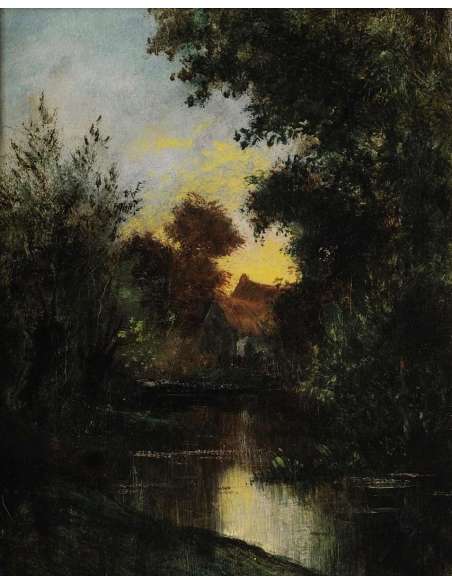"Jules DUPRÉ (1812 – 1889) French - Mare at dusk."
Oil on canvas monogrammed J.D. at the bottom right
Dimensions: 39 x 31.5 cm, with frame: 60 x 53 cm
Born in 1811 in Nantes, Jules Dupré is regarded as one of the best landscape painters of the century (Bénézit, p. 77). His influences are multiple. He studies the Dutch masters and admires Rembrandt. During his stays in London, the painter was marked by the English landscape painters, in particular the master of landscape, Constable who would profoundly influence his work.
A pleinairist attached to the Barbizon school, Jules Dupré took advantage of the invention of the paint tube in the early 1840s and the development of railway lines around Paris to put the lights of nature to the test with his brush.
Jules Dupré is the founder of the modern French landscape school, one of the five creators of the Barbizon school with Rousseau, Millet, Daubigny, Corot.
His meeting with Theodore Rousseau was decisive, he painted alongside him on the motif in the forest of Fontainebleau and learned to look at nature with sincerity and depth.
He practices a landscape painting characterized by light effects and impasto of the pictorial material.During exhibitions at the Salons, his works are noticed.
At the Salon of 1835, Eugène Delacroix congratulates him on the quality of his skies.
Camille Corot calls him the "Beethoven of the landscape".
Through Van Gogh's correspondence to his brother, we can read the painter's deep admiration for his elder.
J. Dupré, with a passionate and romantic temperament exalted by the landscape of nature, was also a precursor of Impressionism.
He experiences the outdoors, he paints the calm of nature in opposition to the bustle of the city in full industrial expansion.
Sensitive painter, he represents here a morning scene, far from the mythological clichés of the wild nature. The dark masses of the trees stop our gaze. Like a frame within a frame, the trees invite you to follow the clear river from the first light of day towards the cottage in the center of the canvas, hidden by nature. The touch is lively, it is the sign of the gesture that precedes Impressionism. Lighter, the bristles of the impasto brushes are enough to suggest the movement of the wind in the leaves.
Looking at this painting, we can understand the admiration that Van Gogh had for the artist. Perhaps he detected in his work an avant-garde form of expressionism. The treatment of nature and light, marked by an intense yellow impasto, in this strong work by Jules Dupré is a revealing one.
Bibliography:
. Exhibition "The Barbizon School: painting in the open air before Impressionism", Museum of Fine Arts of Lyon, 2002.
. Emmanuel Bénézit,Dictionary of painters, sculptors, draftsmen and engravers, volume II, Gründ Bookstore, ed. 1976.
Museum:
. Louvre Museum, Orsay Museum, Paris. National Gallery of Art. Senlecq L'Isle Adam Museum, Reims Museum of Fine Arts, London, Saint Petersburg (The Hermitage), New York (Metropolitan, Frick Collection), Washington, Memphis, Saint-Louis
Description
Reviews
No reviews
Jules DUPRÉ (1812 – 1889) French - Mare at dusk .
Vendu
11000 €







Period:
XIX th c.
Style:
Classical Art
Material:
Oil on canvas
Signatures:
Jules DUPRÉ
Origin:
French school
- Widht :
- 31,5 cm (12,29 In)
- Height :
- 39 cm (15,21 In)
2023-02-06
671 people viewed this item

 English
English  Français
Français






